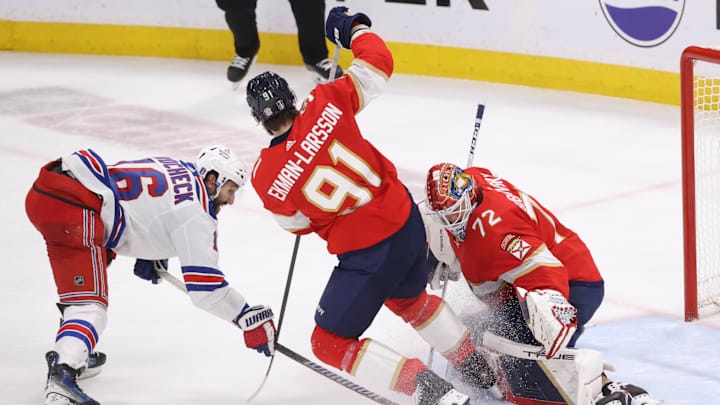There were very few positive moments on Tuesday night at Amerant Bank Arena for the New York Rangers. Most of the takeaways from that contest were negative, and a few negative giveaways as well (looking at you, Mika Zibanejad).
But despite being utterly dominated for most of the action in Games 3 and 4 in South Florida, the club did find something to build off of.
It is not the masterful performances of Igor Shesterkin, who stopped 70 of a total 77 shots faced through the two outings. Quick math indicates a .909 save percentage (SV%) - not quite sparkling given the expectations for Shesterkin - but he was particularly phenomenal in those two games.
The Czar, as he is so affectionately known, stopped 14 of a whopping 18 high danger shots faced across May 26th and 28th in Florida. The Rangers were out-attempted 197-87 total across both contests. Shesterkin is the reason New York escaped South Florida with a victory and had any shot at possibly stealing two.
Shesterkin’s excellence was well documented entering both games in Florida, with those two outings simply validating that concept.
The power play
No, the positive takeaway was the Rangers power play. It’s shocking that would need to be stated, being that the club finished as the third best during the regular season with the man advantage, operating at 26.4 percent.
But entering Game 4, New York’s superb power play had been anything but, going 1-for-18 with the man advantage since Game 3 of their second round series against the Carolina Hurricanes.
The club looked hesitant and out of sync, reluctant to get shots on net during the lull. In 18 power plays during the previous seven games, New York recorded a total of 24 shots, or 1.33 shots per power play.
Of the four teams remaining in the Stanley Cup Playoffs, the Rangers recorded the fewest shot attempts when on the power play since Game 3 against Carolina (May 9th). The Panthers have recorded the most shot attempts while up a man (102), while Edmonton (72) and Dallas (70) both had a large gap in shot attempts compared to the Rangers 53.
Granted, the Panthers spent almost 20 minutes more with the man-advantage in that span than the other three clubs, but the Rangers lack of shooting is still evident (all stats via Natural Stat Trick).
So what changed?
The stubbornness or reluctance to shoot seemed to subside in Game 4. The Rangers notched 15 shot attempts in their 3 power play opportunities on Tuesday, with a majority of them finding their way to the net (10 shots on goal) and of course one reaching the back of the net.
VINCENT TROCHECK! 🤩
— NHL (@NHL) May 29, 2024
What a shot for his eighth goal of the postseason! #StanleyCup
🇺🇸: @espn & @ESPNPlus ➡️ https://t.co/Pp9X7OGP3W
🇨🇦: @Sportsnet or stream on Sportsnet+ ➡️ https://t.co/sEijvXhbA1 pic.twitter.com/XCKHXTlHp1
They looked more like the potent power play that commanded respect from opponents during the regular season and early on this postseason. They were active, moving the puck with a purpose and rarely found themselves stationary.
Chris Kreider was active around the goal crease. Adam Fox seemed more like himself, confidently walking the blue line and drawing defenders toward him before moving the puck to the open man. Zibanejad was shooting, even hitting a post in the first period. Vincent Trocheck, who scored the Rangers first power play goal of this series, was all over the ice.
This was the power play the Rangers were banking on being major contributors in the club’s success. There is plenty more for the club to address heading into Game 5 at Madison Square Garden, but their worries on the power play may have been alleviated after the performance in Game 4.
The New York Rangers fall in overtime in Game 4 against Florida
